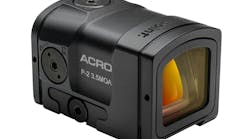Assault Rifle. Patrol Rifle. Assault Weapon. How many different wordings have we seen used to describe a semi-automatic, box magazine fed shoulder fired weapon? Too many. How about one that we can actually call what it is? Battle Rifle. Not only a type of tool to be used but also the name of the company that manufactures them. I’d never heard of the company up until last year and then I got the contact, received one for test & evaluation and will never again call this type of rifle anything else: Battle Rifle. Take a look.
Many of us are familiar with the model designations that are so commonly used, even when they’re not properly applied. “It’s an M16.” “It’s an M4.” “It’s an Ar… anything.” The Battle Rifle I received was built on the company’s BR4 platform – which is their semi-automatic, box magazine fed weapon line built to chamber the 5.56mm, 6.8mm or .300 Blackout. The one I received was their BR4 Spectre variant chambered in 5.56mm.
Let’s take a quick look at the specs and then we can talk about performance, comfort, confidence and all the other subjective shooter related items that really bond us to a weapon. So, the specs…
- Weight: With a 30-round magazine, depending on “trim”, 5.5-7.2 pounds
- Caliber (specified as “Bore Diameter” on the website): 5.56mm unless otherwise specified
- Maximum Effective Range: 400 meters
- Area Target: 800 meters
- Muzzle Velocity (ammo type not specified): 850 meters per second
- Rifling Twist rate: EITHER 1:9” or 1:7” dependent on trim
- Muzzle Device: A2, BRC Flash Suppressor OR a Muzzle Break
- Trigger: Standard trigger polished and adjusted to 4-6 pounds
- Overall Length: 24-35.5 inches (barrel length and stock extension dependent)
- Accuracy: ½ to 1 MOA
Those are the standard BR4 specifications. As I stated, I received a BR4 Spectre model, so the following needs to be added on:
- Battle Rifle Flash Suppressor
- Flip-Up front and rear sights
- 12 inch free float quad rail with continuous top rail
- Ergo pistol grip
- Buttstock Pad
- Micro Gas Block under Quad Rail
- Single Point Sling Adaptor
- Single state polished trigger set
- Available with standard SOCOM profile OR HBar option (I received standard SOCOM)
- Custom stock from Choate
The rifle I received had one more “non-standard” item (in my experience) that I really appreciate: a charging handle with a larger spring loaded catch than I’ve ever seen. I’m so used to the military-style, minimum sized catches that this over-sized one just seems so… luxurious. It made yanking that charging handle a LOT easier for sure. There’s more to grab onto no matter how you’re doing it.
One final note: The rifle I received has a 16” barrel plus the 2” Battle Rifle Flash Suppressor for an overall length of 18”. As much as we see shorter barrels these days – most of them totally 16.25” to meet the federal barrel length minimum, I still tend to prefer the 18”-20” barrel length, probably for the same reason I still like my Government Model 1911 handguns: it’s what I first learned on. Back in the early ‘80s when I was an MP, my M16 had a 20” overall barrel length, including the A2 flash suppressor. As manageable, maneuverable and convenient those shorter barrels are, I like my rifle to feel (to me) like a full size rifle. This Battle Rifle B4 Spectre just fit my preferences perfectly.
Rifle in hand, with a can of mixed ammo (different manufacturers, weights, etc), ear and eye protection, various targets, a small bottle of MiliTec and two different kinds of magazines (P-Mags and D&H Industries metal mags), I headed for the range. As I was taught to do (way back in the day and courtesy of Uncle Sam’s Army), I zeroed the mechanical sights at 25 yards. The sights, front and rear, are spring-loaded pop up sights which can serve well as primary sights but serve better as emergency backup sights. If you use them as backups, obviously you need to mount an optic on the rifle AND it needs to sit at the right height so that if it goes out of service you can use the mechanical sights looking THROUGH the dead optic. You also have to mount the optic in a position far enough forward that lets the backup rear sight actually pop up when you need it. The other option is to replace the popups with 45° offset sights but I prefer the popups.
At any rate… zeroed the mechanical popup sights and then set my targets at 100 yards (five of them). The published material says the rifle will shoot between ½ and 1 MOA. I inserted a 30 round magazine and, from a bench rested position, fired five 3-shot groups; one on each target. I cleared and safed the rifle and headed down range to see how I’d done (or more importantly, how the rifle had done, assuming I did my part right).
I had fired four decent groups – the fifth group I had a called flyer (because even when you’ve been shooting as long as I have if you don’t pay attention it’s easy to jerk the trigger, flinch, etc). The four groups measured, listed in smallest to largest:
- .34”
- .36”
- .55”
- .6”
That’s two groups that were sub-1/2 MOA and two that were in the published spread: between ½ and 1 MOA, closer to the ½ MOA size. If I hadn’t ruined the fifth group, it looks like it might have been sub ½ MOA as well.
I replaced the targets and went back to finish out the magazine with another five 3-shot groups. Paying more attention to my basic marksmanship skills, I was able to reproduce the performance of my first attempt. This time I kept all five groups tight and ended up with three groups that were sub ½ MOA and two groups that were right at the ½ MOA mark: one was .5” exactly and the other was .53”. To say that I was pleased (with the rifle and myself) would be an understatement.
That concluded my first range day accuracy test but I still had all that ammo so I set up a series of targets to shoot for fun and to test reliability. I spaced them out between 25 yards and 100 yards (maximum available on that range) and set about emptying six more magazines of ammo from the bench. Through that additional 180 rounds of ammo fired, I had no failures to eject, jams, etc. The rifle really cleared the brass with most of it popping out to land some fifteen to twenty feet away.
I did have, in the last few rounds of the seventh magazine I fired, a fail to fully chamber – but I hadn’t lubed the gun to begin with and I was near the end of the seventh magazine. I tapped the bolt assist and kept on rocking. The fail to fully chamber may have been the fault of the dirty chamber, or a piece of dented brass or something else not diagnosed. I had no more issues after that one and finished my fun.
Then I realized that I’d done all my shooting from the bench rest and I simply couldn’t go home with a dirty rifle from ONLY bench rested shooting. So, I filled six more magazines and put up some new targets. I also pulled the bolt, wiped it down and gave it a quick wipe with a MiliTec wet swab.
I fired the first of the remaining six from the prone position at 100 yards. Most of my recent prone shooting has been done behind a bipod supported bolt gun, but this was enjoyable and my elbows didn’t suffer much.
Standing, I reloaded another mag and went through two magazines alternating between targets: 25, 50, 100, 50, 25 and so on. Target acquisition was as expected and familiar with the mechanical sights. I took just enough time to get a decent sight picture between each shot, trying to push time a little bit but not so much that I’d ruin my shooting.
I spent the next two magazines moving steadily down the range engaging the targets on the move. When I got to within ten yards (I’m guessing) of the 100 yard target, I safed the weapon, let it hang on the single point sling and walked back to start over again. As much as I was tempted to back up while engaging the targets I could just envision myself tripping, falling and firing a round off in a negligent fashion. Safety first.
The last magazine I went through doing simulated malfunction drills where I simply safed the gun, let it hang and switched to my secondary; in this case, a 4th Gen Glock 17 9mm handgun. Two from the rifle, safe, let it hang, two from the handgun. All those rounds were fired on the 25 yard target from the firing line.
By the time I was done for the day, I’d put 13 magazines of ammo through the rifle – 390 rounds. I had had one fail to fully chamber, cause unknown but not, as far as I was concerned, the fault of the rifle in any way (it usually isn’t). I’d put two magazines of ammo through my handgun and had lots of brass to pick up from all over the range. When I went to pull down the targets, I realized that instead of stapling them (as I usually when testing), I’d used spray adhesive and had, therefore, covered up and shot through, my accuracy test targets. What I had left, however, showed every shot within a 4”-6” spread and those shots were the ones fired prone, moving, at various distances and during malfunction drills. For BATTLE purposes that’s more than sufficient.
On the Battle Rifle website, the BR4 Spectre has a price of $1,195. Rounded off, $1200 is a darn good price for a rifle with these features and that kind of performance. The BR4 line runs anywhere from $995 for the BR4 Trooper to $1795 for the BR4 DMR (Designated Marksman Rifle).
Overall I was very pleased with this weapon; so much so, in fact, that I will use it as the platform for future articles testing accessories for such rifles. Additionally, while there are a great many manufacturers of semi-automatic rifles using this same basic design, when you compare features to price, the Battle Rifle comes out on top (in my opinion). For more information, check out Battle Rifle Company online.
Stay safe!



